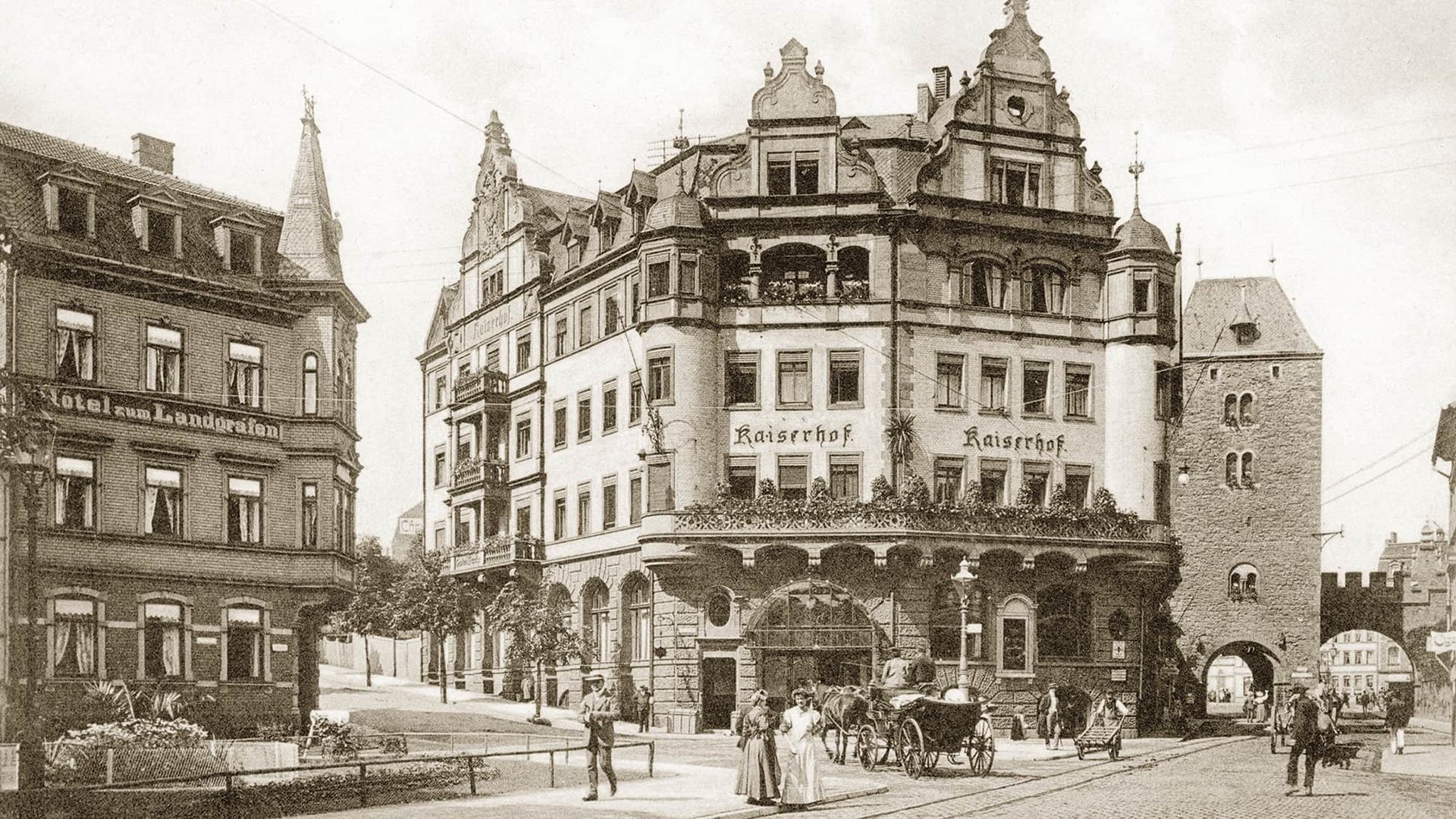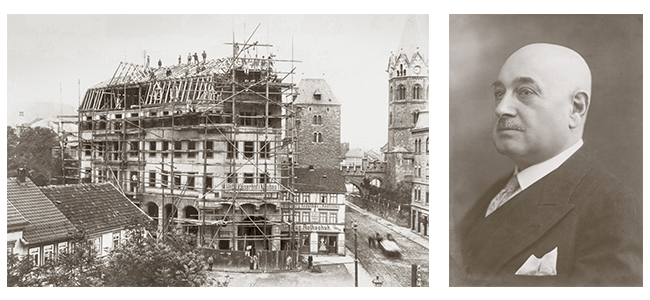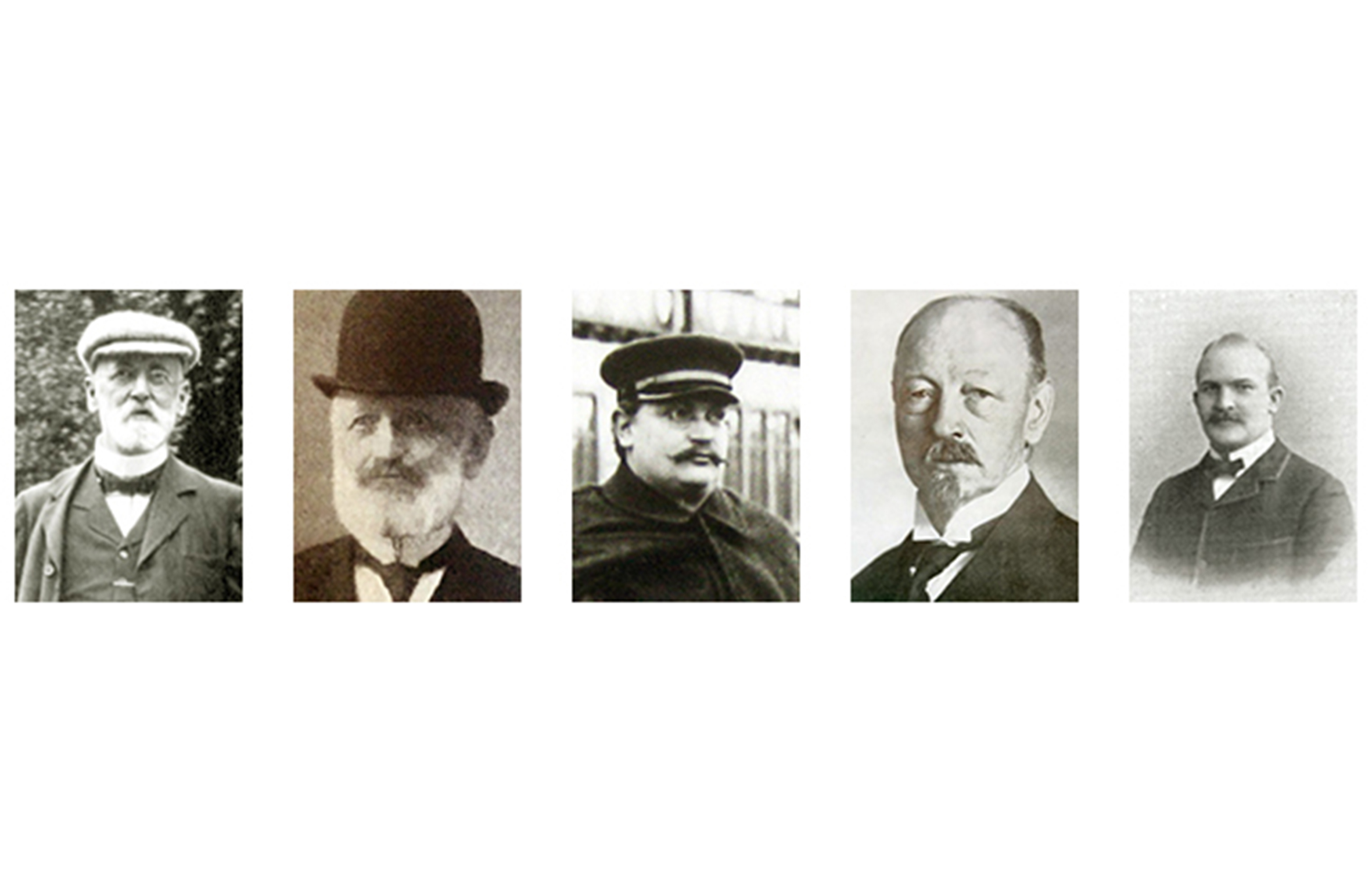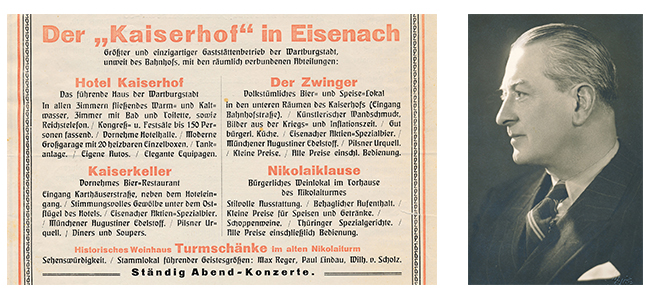History
arrival
departure
persons
Time travel through the Kaiserhof
The Hotel Kaiserhof in Eisenach looks back on an eventful history. Since it opened in 1897, it has undergone numerous changes. Originally built by Gustav Franke, the hotel became a central location for travelers and events, including the founding of the Association of the Automobile Industry in 1901. It fell into disrepair during the GDR era, but was given a new lease of life after reunification with a major renovation. Today the Kaiserhof combines historical charm with modern comfort.
The Hotel Kaiserhof is built
The Hotel Kaiserhof was built in 1895-97 according to a design by the Berlin architect Otto March and opened on December 19, 1897 by the Eisenach restaurateur Gustav Franke.
The picture on the left shows the ensemble with the original buildings, the photographs below show the hotel under construction and the restaurateur Gustav Franke.
Opening of the "Kaiserhof
Gustav Franke knew what he was doing when he settled centrally, in front of Carlsplatz, at the medieval Nikolaitor, and opened the "Kaiserhof" there on December 19, 1897.
The difficult task of harmoniously integrating a new modern hotel building into the magnificent ensemble of the city gate and the Romanesque Nikolai Church was masterfully solved by the well-known architect Otto March.
The ingenious master builder refrained from looking for ways to adapt to the old, existing buildings in an early medieval style - instead, he boldly created a Renaissance building that blended in exceptionally well with the image of the gate.
In the immediate vicinity of the Kaiserhof, Gustav Franke had a smaller and simpler-looking counterpart, the Hotel zum Landgrafen, built. It was completed and leased on April 3, 1898.
Foundation of the "Association of the Automotive Industry“
Gustav Ehrhardt, director of the Eisenach vehicle factory, succeeded in inviting Germany's leading vehicle manufacturers to a meeting of manufacturers in Eisenach at the beginning of 1901. On January 19, 1901, the Verein Deutscher Motorfahrzeug-Industrieller (Association of German Motor Vehicle Manufacturers) was founded in the Kaiserhof Hotel. It was given a new name "Verband der Automobilindustrie" (Association of the Automotive Industry) in 1946.
The founding board of the VDMI (from left to right):
- Gustav Vischer (Daimler-Motoren-Gesellschaft, Cannstatt),
- Baron Eugène de Dietrich (De Dietrich et Co., Niederbronn),
- Gustav Ehrhardt (Fahrzeugfabrik Eisenach),
- Ben Rachor (Adlerwerke, formerly H. Kleyer, Frankfurt am Main),
- Willy Tischbein (Continental-Caoutchouc- und Gutta-Percha Compagnie, Hanover)
Gustav Vischer became the first chairman, Eugène de Dietrich his deputy.
Acquisition of the vinegar factory
The owner of the Kaiserhof also recognized the development potential of the time and purchased the former vinegar factory in 1908 in order to use it for his hotel as a service building and space for a vehicle fleet.
In the following years, neighboring properties adjacent to the Kaiserhof continued to be acquired in order to gain a free hand to develop the area into a large block as a triangle from Bahnhofstrasse - Karthäuserstrasse to Karlsplatz.
1908
Acquisition of the vinegar factory
Acquisition and new construction of the Turmschänke
When in 1910 the tourist traffic of the Wartburg town had grown steadily, a highly frequented bottleneck arose with the narrow passage through the medieval Nikolaitor, through which now also the streetcar drove, and in addition served as a pedestrian way. This life-threatening "facility" had to be remedied.
The municipality therefore decided to buy the adjoining tower house from the Thuringian state in order to take the traffic of the public out of the cramped little archway. The municipal council approved 45000 marks for the planned new building and at first intended to erect a store with a mezzanine floor and two small apartments on the site of the small tower house.
However, before the planned new building was started, the owner of the Hotel Kaiserhof made a proposal to the town council to build a wine bar on the site. The proposal was accepted and the "Turmschänke" was built according to Mr. Franke's wishes and furnished by the hotelier himself.
The picture (1875) shows the access road to Carlsplatz from the east before the remodeling.
Ownership of the "Turmschänke"
In 1918 the Turmschänke became the property of the "Kaiserhof". Hotelier Franke was able to transform the medieval defense tower, built in 1070, and the later "civil custody" into a cosy tower dungeon, a "jolly prison" and a tasteful wine tavern on the first and second floor. On the first floor, the Nikolaiklause was established as a bourgeois wine tavern with an open wine bar.
What the Ratskeller is in Bremen, the Batzenhäusl in Bolzano and Auerbach's Keller in Leipzig, the "Turmschänke" is in Eisenach. In the evenings, locals and locals from Eisenach feast on exquisite culinary delights and also enjoy musical performances.
Famous personalities often stayed here as guests. Paul Lindau, for example, once sat here and, taking a thoughtful drag on a cigar, put "Memories" down on paper. Max Reger also liked to reside here and drop his humorous, punchy word jokes into the art-loving chatter of his surroundings. Furthermore, among the intellectual paladins of the "Turmschänke" was the subtle poet Wilhelm von Scholz, who belonged to the officer corps of the Eisenach garrison in the years 1914/16. In memory of happy hours he dedicated atmospheric poems to the "Turmschänke", the original of which still adorns the restaurant today.
The Kaiserhof becomes more modern
In 1920, the new 400m² central kitchen was installed in the Hotel Kaiserhof, which was to supply all the Kaiserhof inns. In 1921, the entire hotel was equipped with hot and cold running water, as well as a large number of guest rooms with private bathrooms and Reich telephones.
In 1922, a modern steam laundry and refrigeration plant were added. In order to meet the increased demands of the traveling public, the construction of a large, comfortable hotel hall - one of the most beautiful in Thuringia - followed in 1923/24, as well as the establishment of a conference hall.
The ever-increasing car traffic urgently required the creation of suitable storage rooms, so in 1925 a modern large garage with 20 heatable individual boxes, a large roofed washroom, a repair workshop and a tank facility was built on the business property.
Opening of the "Zwinger" Beerhouse and Restaurant
In 1926, on the ground floor of the Kaiserhof, the bourgeois beer and food restaurant "Der Zwinger" was established, where historic murals, collections of stamps, banknotes and old documents remind of the difficult war and inflation period. In the following year, the adjacent "Kaiserkeller" was renovated and turned into one of the most beautiful and comfortable beer restaurants in Eisenach. Thus, the Kaiserhof restaurants were able to meet all the demands of their guests and their budgets. When the heating system was renewed in 1927, a modern well system was also created, which with its water vein supplied all the establishments with the best mountain water.
The wish of Mr. Gustav Franke to crown his work with an extension between the "Kaiserhof" and the "Turmschänke" remained denied to him during his lifetime. Despite repeated building applications in the years 1921-1923, as well as 1925-1926 and drafts of well-known architects arranged by him, an agreement with the municipal building authorities about the kind and height, as well as about the economic use of the new building could not be reached. Thus the hotelier Franke had to give up with a heavy heart to be able to present the city of Eisenach with an entrance gate in front of the Nikolaitor, as it is probably offered only by very few cities in Germany. What the planned building was to look like after its completion is shown in the picture below.
Alfred Franke becomes hotelier of the Kaiserhof
In 1937 Gustav Franke died as a result of severe sepsis. After his father's death, his son Alfred took over the business as hotelier in 1939 and continued his father's legacy. However, this was to be short-lived.
From 1933 and through the war period, the Kaiserhof also had to serve as a preferred meeting place for the ruling National Socialists in its capacity as the 1st hotel on the square.
The Kaiserhof is renamed the "Parkhotel"
On April 6, 1945, the city was handed over to the Americans. On the same day, the first talks between Eisenach's mayor Rudolf Lotz and American officers took place at the Kaiserhof. After the Red Army replaced the Americans as the occupying power on July 2, 1945, the hotel briefly served as accommodation for the Russian command and was renamed the "Parkhotel" in 1945 on the instructions of the Soviet occupying power. In August 1949, Alfred Franke was arrested by the Soviets. His family did not learn until a year later that he had been imprisoned first in Waldheim and later in Bautzen. He was sentenced to 25 years in prison for alleged high treason and his property was expropriated. An official certificate from 1945 about his political "harmlessness" testifies to the arbitrariness of the new rulers against him as a capitalist entrepreneur and thus a supposed "enemy" of the working class. Alfred Franke died of heart failure on March 16, 1957, at the age of only 61, 7 months after his release from the Bauzen prison. The long imprisonment had broken the physical power of resistance of the man who until the end was optimistic for a future in freedom. He found his final resting place in the family grave of the Franke family in Eisenach, next to his parents Olga and Gustav and his brothers Kurt and Paul Franke who had died in the war. In 1993/94 Alfred Franke was fully rehabilitated by the Russian Prosecutor General... Until the GDR wall was built in 1961, the hotel still experienced luxurious times, as many Americans and West German businessmen stayed here. Later, the "socialist planned economy" and the accompanying need to procure building materials caused structural decay.
The Parkhotel shines in new splendor
On the occasion of the jubilee "900 years of Wartburg" a comprehensive renovation took place in 1967. The political leadership in the GDR became aware that the obvious decay of the centrally located hotel on the one hand and the honoring of historically significant buildings on the other hand could hardly be propagated for the image of a flawless socialism.
Only 20 years later, a lack of care in the GDR's planned economy again reveals a disastrous picture of decay.
Fundamental renovation of the hotel by the Miller family.
In 1991, the Treuhandanstalt sold the hotel to the private investor, Mr. Nicholas Miller, who started the renovation of the building in 1992 and reopened it on July 14, 1993 under the original name Kaiserhof.
In the same year, the hotel was extended with an annex that closed the gap between the building and the Nikolaitor. In the course of the fundamental renovation of the hotel, the Paulaner-Thomasbräu AG converted the premises of the Zwinger back into a good middle-class restaurant with food service for Paulaner beers. The tenant, Mr. Winfried Günther, ran the traditional restaurant faithfully according to old principles, "excellent quality of food and beverages at middle-class prices" and with "courteous and obliging service".
The historical wine restaurant "Turmschänke" was also renovated and since then has been pleasing its guests with exclusive cuisine in a historical ambience. It also offers a guest room in the Nikolaitor, the only preserved city gate in southern Thuringia from the Middle Ages.


















